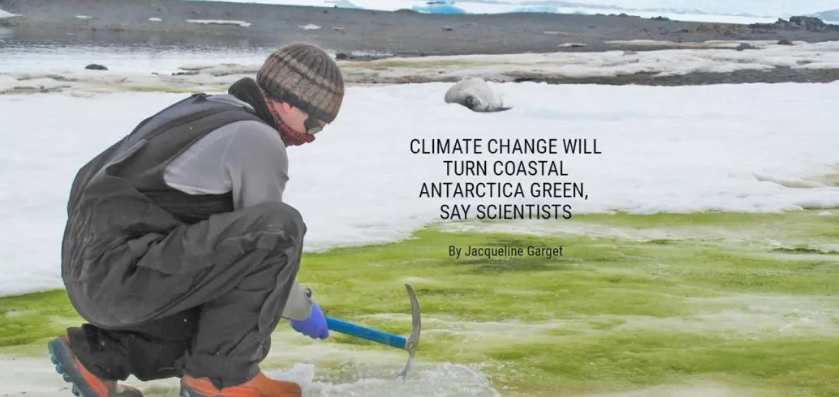CLIMATE CHANGE WILL TURN COASTAL ANTARCTICA GREEN, SAY SCIENTISTS
The snow is multi-coloured in places, with a palette of reds, oranges and greens - it’s quite an amazing sight.
——Dr Matt Davey ,
University of Cambridge’s Department of Plant Sciences

科学家们绘制出了有史以来第一张大规模微型藻类地图,这些藻类在南极洲半岛沿岸的冰雪表面迅速繁殖。结果表明,随着全球气温升高,这些“绿雪”可能会扩散。
Scientists have created the first ever large-scale map of microscopic algae as they bloomed across the surface of snow along the Antarctic Peninsula coast. Results indicate that this ‘green snow’ is likely to spread as global temperatures increase.
由来自剑桥大学和英国南极调查局的研究人员组成的小组将卫星数据与南极洲两个夏季的地面观测相结合,对绿雪藻进行了探测和测量。虽然绿藻的个体很微小,但当它们成群结队地生长时,雪地会被染成鲜绿色,从太空中都可以看到。这项研究成果已经于今天(5月20日)发表在《自然通讯》期刊上。
The team, involving researchers from the University of Cambridge and the British Antarctic Survey, combined satellite data with on-the-ground observations over two summers in Antarctica to detect and measure the green snow algae. Although each individual alga is microscopic in size, when they grow en masse they turn the snow bright green and can be seen from space. The study is published today (20, May) in the journal Nature Communications.
剑桥大学植物科学系的马特·戴维博士说:“这是我们对南极洲陆上生命了解的重大进展,随着气候变暖,它们可能会发生变化。雪藻是南极大陆通过光合作用从大气中捕获二氧化碳的能力的关键组成部分。”
“This is a significant advance in our understanding of land-based life on Antarctica, and how it might change in the coming years as the climate warms,” said Dr Matt Davey in the University of Cambridge’s Department of Plant Sciences, who led the study. “Snow algae are a key component of the continent’s ability to capture carbon dioxide from the atmosphere through photosynthesis.”
在南极海岸线周围,特别是南极半岛西海岸的岛屿上,都有绿色雪藻的生长。它们生长在"更温暖"的地区,那里在11月至次年2月的南半球夏季的平均温度刚刚超过零摄氏度。半岛是南极洲的一部分,在上个世纪后期经历了最快速的变暖。
Blooms of green snow algae are found around the Antarctic coastline, particularly on islands along the west coast of the Antarctic Peninsula. They grow in ‘warmer’ areas, where average temperatures are just above zero degrees Celsius during the austral summer - the Southern Hemisphere’s summer months of November to February. The Peninsula is the part of Antarctica that experienced the most rapid warming in the latter part of the last century.
研究小组发现,绿雪藻的分布也受到海鸟和哺乳动物的强烈影响,它们的排泄物作为一种高营养的天然肥料,加速了藻类的生长。超过60%的雪藻被发现在企鹅群落五公里范围内。在其它鸟类的筑巢地附近,包括企鹅的巢穴和海豹上岸的区域,也观察到了藻类的生长。
The team found that the distribution of green snow algae is also strongly influenced by marine birds and mammals, whose excrement acts as a highly nutritious natural fertiliser to accelerate algal growth. Over 60% of blooms were found within five kilometres of a penguin colony. Algae were also observed growing near the nesting sites of other birds, including skuas, and areas where seals come ashore.
研究人员使用了欧洲航天局 "哨兵2号“卫星在2017年至2019年期间拍摄的图像并将这些图像与在南极洲的莱德湾、阿德莱德岛和乔治王岛的菲尔德斯半岛的地面测量结果相结合。
The team used images from the European Space Agency’s Sentinel 2 satellite taken between 2017 and 2019, and combined these with measurements they made on the ground in Antarctica at Ryder Bay, Adelaide Island, and the Fildes Peninsula, King George Island.
戴维说:“我们发现了1679个单独的绿藻繁殖区域,其面积加起来达到了1.9平方公里,每年相当于约479吨碳汇,在英国就是87.5万辆汽油车排放的碳量。
“We identified 1679 separate blooms of green algae on the snow surface, which together covered an area of 1.9 km2, equating to a carbon sink of around 479 tonnes per year” said Davey. Put into context this is the same amount of carbon emitted by about 875,000 average petrol car journeys in the UK.
几乎三分之二的绿藻都生长在没有高地的低洼小岛上。随着南极半岛因全球气温上升而变暖,这些岛屿可能会失去夏季的积雪覆盖,也会随之失去雪藻。然而,就质量而言,大部分雪藻都是在半岛北部和南希德兰群岛生长,在这些地区,随着低洼的积雪融化,雪藻会扩散到更高的地方。
Almost two thirds of the green algal blooms were on small, low-lying islands with no high ground. As the Antarctic Peninsula warms due to rising global temperatures, these islands may lose their summer snow cover and with it their snow algae. However, in terms of mass, the majority of snow algae is found in the north of the Peninsula and the South Shetland Islands, in areas where they can spread to higher ground as low-lying snow melts.
文章第一作者安德鲁·格雷博士说:"随着南极洲变暖,我们预测雪藻的总质量将增加,因为其向高地的扩散速度远远超过了低洼小岛屿上的损失速度"。
……
“As Antarctica warms, we predict the overall mass of snow algae will increase, as the spread to higher ground will significantly outweigh the loss of small island patches of algae,” said Dr Andrew Gray, lead author of the paper.

 中文
中文 English
English
